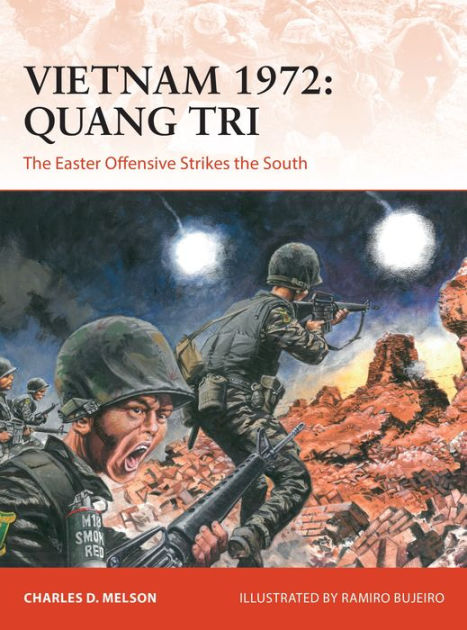Reviewed by Jeff Schultz
Charles Melson’s Vietnam 1972: Quang Tri – The Easter Offensive Strikes the South provides a concise look at the role played by the South Vietnamese Marine Corps (VNMC) and their US Marine Corps (USMC) advisors during Hanoi’s 1972 Easter Offensive. The South Vietnamese defenders, in particular the VNMC, alongside American air and naval support acted as a temporary validation of President Nixon’s Vietnamization policy and forestalled the catastrophic fall of Saigon for several years.
Melson is a prolific author and the former Chief Historian for the U.S. Marine Corps, with many titles to his credit chronicling the U.S. Marine experience and other topics. This 96-page Osprey monograph is divided into several sections: “Origins of the Campaign,” “Chronology,” “Opposing Forces and Commanders,” “Opposing Plans,” “The Campaign,” and “Aftermath” along with a bibliography, acronyms, and index; well-supported by many photos, detailed color maps, orders of battle, and a selection of color plates.
Melson focuses on the 1972 fighting in and around I Corps Tactical Zone [I CTZ] which bordered North Vietnam in one of the most contested areas of the conflict. After the initial People’s Army of Vietnam (PAVN) assault overwhelmed the ARVN (Army of the Republic of Vietnam) defenses (especially the 3d ARVN Division), the important city of Quang Tri was lost, the largest city lost early in the offensive. The period 1969 to 1972 saw the slow drawdown of the massive American commitment to the South Vietnam, which meant that by early 1972 the defense of the country rested on the ARVN with supporting American air and naval forces instead of the previous arrangement built around massive American ground forces which had existed since 1965 under President Lyndon Johnson. Melson details the ARVN defeat, then proceeds to spend much of his time covering the critical counterattacks which eventually brought Quang Tri back under the control of the VNMC, which slowly won back the lost terrain across several months with heavy support by the US Navy offshore gunfire support, US Air Force and USN airstrikes plus whatever the South Vietnamese Air Force could muster.
Melson characterizes the VNMC as more successful than some American and South Vietnamese contemporaries have portrayed them. His argument is that they were less the problem and more the solution that Saigon needed, especially when compared with the ARVN, which fared poorly on multiple occasions during the Easter Offensive. Not only did the VNMC recover after the initial attacks and bring the fight back to the enemy which led to the recapture of Quang Tri, they had only been acting as a divisional-sized formation for the first time in 1972, having steadily grown over the years until they could field three brigades which were grouped with supporting units into the South Vietnamese Marine Division. Even after the 1972 fighting ended the VNMC continued to be one of the more reliable formations available to President Thieu’s regime, well into the 1975 fighting when the division had the nearly impossible task of disentangling itself from Da Nang via the ex-American ships of the South Vietnamese Navy. This withdrawal proved very costly, with deaths to drowning and those unable to swim left behind to their fate. Remaining VNMC units fought in the Saigon area until the final collapse in April 1975.
A particularly fascinating vignette concerns the role of USMC Major John Ripley and US Army Major James Smock as they attempted to destroy the Dong Ha bridge over the Cua Viet River in the face of the overwhelming PAVN assault, a success under incredible duress with few comparisons. Ripley laboriously placed the charges with help from Smock, only a short distance from the enemy and eventually detonated them successfully, dropping the American-built bridge into the river. While this legendary incident that earned Ripley the Navy Cross played a vital role in blunting the enemy advance it is not well known to the general public. What is also not known is that only with the help of a VNMC sergeant who damaged the lead PAVN tank, Ripley and Smock’s later success became possible.
Melson provides excellent supporting information about the background of the VNMC, their leaders, training, uniforms, tactics, and equipment along with a host of other details which help to not only provide a basic understanding of the Marines, but also the North Vietnamese Bo Doi they faced, along with their leaders, plans, equipment, and other relevant content which belies the relatively short length of the work.
Besides the focus on the VNMC, the book tackles the critical role American advisors played in the later stages of the fighting as one of the ways to effectively implement Vietnamization. American advisors at battalion and higher level provided key dividends assisting the ARVN while also providing valuable advice at difficult times to help forestall defeat. American advisors were nothing new in South Vietnam, going back to the Eisenhower and Kennedy years when the “co vans” provided advice to the fledgling ARVN who had years of French assistance previously.
Charles Melson’s Vietnam 1972: Quang Tri – The Easter Offensive Strikes the South fills an important place in the post-Tet 1968 literature of the Vietnam era which illuminates the struggles to implement Nixon’s Vietnamization policy amid considerable upheaval. Overall, the mix of photos and color plates helps to reinforce the key concepts which is a typical hallmark of this series. Supporting visuals aside, Melson provides a lively treatment of an obscure story that is often ignored once the conflict reached 1969. It is a tribute to the US Marine Corps and the VNMC they helped to forge and will appeal to both the casual and more seasoned reader with not only a relevant overview but sufficient detail to satisfy.
A past contributor, Schultz teaches history at a community college in Pennsylvania.
Vietnam 1972: Quang Tri – The Easter Offensive Strikes the South. By Charles D. Melson (Oxford: Osprey Publishing, 2021).


